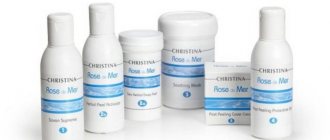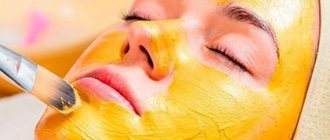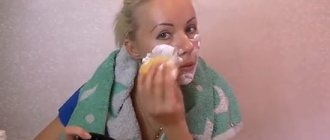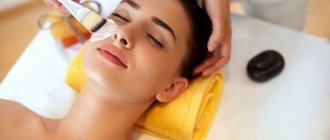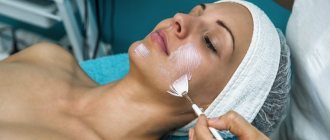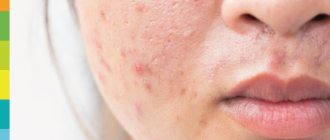Coral peeling is classified as mechanical, because the main component is sharp coral particles that act as an abrasive. Diamond peeling is considered to be an analogue of this procedure, although the technique proceeds fundamentally differently and has a slightly different effect on the skin. The most popular among coral peels are products from the Rose de Mer line, produced by the Israeli manufacturer Christina. This is a mid-surface agent that can have varying degrees of effect depending on the concentration.
What is coral peeling?
Coral peeling is an excellent treatment for acne, scars and pigmentation. Coral peel is safe, consists of natural corals and contains only 1% glycolic acid. There are no side effects, peeling does not make the skin thinner and can be used for a long time. It is not like other chemical peels. The exfoliation process will continue for 1 week after treatment and visible skin improvements can be seen after 6 treatments.
Coral peeling is ideal for treating acne. After approximately 6 treatments, the problem will stop and the skin will become much lighter and healthier. Coral peels are widely used by Korean dermatologists.
Most peelings offered for sale or used in cosmetology centers are chemical-based. The essence of their effect is to corrode the upper layers of the skin, which triggers regeneration processes and renews the surface of the face. After the old layer dies and peels off the face, the patient receives renewed, soft and velvety skin. The main thing to remember is that the natural recovery process cannot be interrupted or forced, that is, crusts with dying skin cannot be removed, they must fall off on their own.
Coral peeling, on the other hand, is made primarily on a natural basis and has a gentler effect on the skin. The degree of impact directly depends on the application technique.
- Firstly, it differs from all other types of peelings in that it contains abrasive particles. Other peels consist almost entirely of acids and additional substances.
- Secondly, coral peeling does not contain (or contains in extremely low concentrations) acid. This completely changes the way the substance affects the skin.
It has a more mechanical effect, so the recovery process is somewhat different from other, more familiar methods. But, still, it is better not to touch your face again until complete recovery; you should also refuse the services of salons that promise to speed up the process with the help of healing drugs.
Always check with your cosmetologist the composition of the drug used and ask to what extent the substance will affect the skin
Positive and negative aspects of the procedure
The procedure for deep cleansing the stratum corneum of the epidermis using coral chips is increasingly popular among women, due to its natural composition and gentle effect, unlike other similar methods. Experts also note the long-term effect of healthy and clean facial skin. The following are all the advantages of the procedure:
- there are no preparatory activities;
- Suitable for all skin types;
- hypoallergenic due to natural ingredients;
- the method of application and the composition of the components allows you to choose the method of influencing the skin: superficial or deep peeling;
- no side effect in the form of severe redness;
Coral peeling does not contribute to sudden and severe redness - visible result of smoothing the skin texture;
- normalizes blood circulation;
- eliminates rosacea in the form of spider veins;
- increases the elasticity and tone of the dermis;
- allows you to maximize the expansion of pores, performing complete cleansing and removing excess sebum;
- the skin becomes healthy, the complexion improves.
The result of the procedure is healthy skin
The negative qualities of coral peeling include side effects that arise due to individual intolerance to the components of the procedure and methods of exposure:
- possible redness and a slight burning sensation;
- the appearance of an allergic reaction, irritation, hyperemia and swelling of the face;
- after the procedure, all of the above side effects may persist for a maximum of 5 days;
- For visible and tangible results, at least 4 sessions are required.
This procedure has its disadvantages
How coral peeling works
The main difference between coral and other types of peelings is that it has an abrasive substance and in some cases acts more gently than acid-containing preparations. On the other hand, why go to a salon for this procedure if you can use regular scrubs, which also have various particles that help exfoliate? But home scrubbing is different. The mild type of coral peeling differs from a regular scrub as it does not damage or dry out the skin. This is precisely the main advantage when compared with self-scrubbing. How is this peeling carried out? The procedure, with a certain application technique, is almost painless and for this reason it is often performed on men who tolerate pain during sessions worse than the fair sex. The mass is evenly applied to the surface of the skin, after which the cosmetologist treats each area of the face with soft massage movements.
Another advantage of this product is that it can be used even on the thinnest and most sensitive skin.
On average, the procedure should be performed 1-2 times a week, but the exact number of sessions should be determined by the attending physician. On the other hand, there are a number of peelings that have a more aggressive composition and affect the skin more actively. These drugs include Rose de Mer Christina, which is able to affect the deeper layers of the dermis (depending on the method of facial treatment and the intensity of the massage). After a session using such peeling, the patient experiences all the “delights” of peeling treatment: tingling, pain throughout the day, dryness and tightness of the skin, cracks in the upper layers of the epidermis.
The application method and type of drug are determined by the attending physician on an individual basis.
Chemical peeling: pros and cons
Peelings are now at the peak of popularity. In modern cosmetology, side effects are minimized, and consumers are fully informed about the procedure and the mechanism of action of acids. Samantha, the heroine of the TV series Sex and the City, with her face the color of ripe cherry, burnt after peeling, is becoming a thing of the past. As a result, only children are not taken to a beauty salon for peeling. Can acids really stop aging?
An excursion into history: when and where it all began
The concept of skin photoaging was developed in the 90s. It was then that scientists identified to the broad masses the main source of all troubles. According to this theory, almost all age-related changes - wrinkles, rosacea, pigmentation - occur due to damage caused by UV radiation and can be corrected if caught in time. The main weapons of the fight are acid peels, antioxidants (another magic word) and, of course, sunscreens.
The cosmetic market responded to the scientists' statements in the same way as always - offering a great variety of new products and procedures. This is how salon peelings, home peelings, serums with various concentrations of antioxidants and prices from 10 to 500 dollars, creams with AHA and BHA acids, sunscreens with nanoparticles and the absence of whitening effects appeared. New theories have also emerged that promise that nutritional supplements will prolong youth and beauty.
And yet, it is peelings that have become the most popular and most in-demand procedure among cosmetologists, in dermatological clinics and at home.
Chemical peels actually date back to ancient Egypt. The Egyptians successfully used lactic and fruit acids for this purpose. It is known for certain that Cleopatra took baths in sour milk and, without realizing it, was “peeled” with lactic acid. Her legacy did not sink into oblivion, but developed and improved. In 1882, salicylic acid, resorcinol and phenol began to be used in Europe. In 1930, peelings came to the United States thanks to Antoinette La Gosse, and from there, as they say, it went from there. Her protégé Cora Galenti made a fortune in Florida practicing wrinkle-smoothing peels.
In other words, controlled skin damage has a long history. Controlled, because that's what chemical peels are all about: using a combination of acidic agents to remove specific layers of skin. By varying the depth of exposure, it is possible to stimulate recovery processes, i.e., increase the production of hyaluronic acid, collagen and elastin, proteins that create a framework for maintaining skin elasticity.
Myths about peeling
Despite the large amount of reliable information explaining the actions and capabilities of peelings, some outdated beliefs and myths still persist. Consider them in order:
- The stronger the better.
“70% peeling with monoacid is better than 30%” - such reviews can often be found in various blogs. However, all aggressive exfoliation really does is strip away your skin and make the healing process more difficult. Doing this is not always the best solution. Modern peels combine several exfoliating acids - glycolic, lactic, azelaic, ferulic, phytic, etc. In addition, the composition often includes citrus extracts and vitamins, for example, retinol (vitamin A), antioxidants (most often resveratrol, genistein and vitamin E), as well as soothing agents (fireweed or aloe) to prevent irritation and redness. The practice has emerged of introducing detox agents and substances that stimulate microcirculation, such as coconut charcoal, into peelings. By reducing the concentration of each acid, combining several substances in one product, we get the maximum effect from each of the acids, while minimizing side effects - redness, burning, peeling. The composition of modern peelings enhances the penetration of antioxidants and vitamins included in the formula into the living layers of the skin. - Peeling
is a sign of peeling effectiveness. This is the most amazing misconception. Clients have repeatedly caused my cosmetologist friends to exclaim, “Oh my God, they want me to rip their skin off?!” Today, when developing peeling systems, along with efficiency, manufacturers are required to ensure maximum safety of the product and minimize side effects. The skin does not have to be “torn off”. There are systems that dissolve dead epidermal cells, usually these are “acid hybrids,” i.e., combinations of various acids, vitamins and antioxidants. The small size of the particles allows them to penetrate deep into the skin (act at the microscopic level). You have complete control over the process of removing damaged skin, smoothing its microrelief, brightening, moisturizing, smoothing wrinkles and restoring elasticity. The most commonly used combinations are retinol, encapsulated glycolic and lactic acids (15% glycolic + 5% lactic) or polyhydroxy acids. An example is gluconolactone; its acidic group is “masked” in the ring structure of the molecule, so it does not cause irritation when it comes into contact with the skin. These peels can be applied to the arms, neck and décolleté. They are suitable for even the most sensitive skin. In addition to improving peeling compositions, the procedures themselves are also being improved. Modern peeling consists of at least three standard blocks: skin preparation, peeling itself and completion of the procedure, which, depending on the needs of the skin, includes soothing gels, masks, and protection from UV radiation. Such procedures may include the alternate application of 5 to 10 drugs; the specialist builds an almost individual program. After completion, you do not see irritation and redness, but there is a positive trend that will intensify over the course of several months. - “Wounds” must take a long time to heal.
This point echoes the previous one, but here we are talking about medium and deep peels, which damage the basal layer of skin and dermis (located between the deepest layer of skin, subcutaneous fatty tissue and epidermis - the outer layer of skin). Of course, it is almost impossible to avoid side effects with medium and deep peels. One way or another, “wounds” form, you feel pain and burning, which can persist for several days or weeks. During the rehabilitation period, it is recommended to apply healing agents such as Panthenol, and in some cases antibiotic ointments. Crusts form on the face, it swells, then the skin cracks and comes off in layers. Thank God, all these horrors are already in the past. Products from modern manufacturers minimize discomfort during peeling and speed up the healing process after the procedure, while maximizing its overall effectiveness. For example, the most traumatic trichloroacetic acid (TCA - the “gold standard” of chemical peels) is today combined with phytic or glycolic acids. As a result, although “crusts” are still present after the procedure, they disappear much faster. In 3-4 days you will be able to lead your normal life, as opposed to 2-3 weeks with a traditional TCA peel. And the procedure itself is much easier than when applying pure acid. Many brands today include a modulator - a system of anti-inflammatory substances and antioxidants with a higher pH, this allows you to regulate the depth and area of peeling, and suppresses inflammatory reactions. Peels of this level are not necessary for everyone; they have previously been associated with certain risks, such as scarring and hyperpigmentation. Today, in order to increase the safety of the procedure and reduce the risks of complications, drugs with antioxidant protection are used at all levels. Special care at home is required, but thanks to the advent of cosmeceuticals, it is not difficult for a specialist to choose the right care.
If you think deep peeling will make you 10 years younger, it won't. Let's say you are 45, after peeling you will still look like a 45-year-old woman, but only fresh and well-groomed, rested and radiant.
- Only one procedure is needed.
In fact, the number of sessions is selected individually depending on the problems that need to be solved. For example, acne treatment often extends over many months and requires repeating the procedure every 2-3 weeks. Medium and deep peels can be performed once. It is commonly said that superficial peeling requires 7–10 sessions, but this is very arbitrary. Today there are systems that give visible results after the first use. Next, the client decides for himself whether he needs to consolidate the result; in this case, at least 5 procedures will be required. - There is no need to spend money on cosmetologists; chemical peeling can be done at home.
Rhonda Allison, founder and CEO of Rhonda Allison Clinical Enterprises, calls peeling an art form and argues that understanding and skill grows with experience—the more experienced the practitioner, the better the procedure and the better results you will receive. A full-fledged chemical peeling, even a superficial one, cannot be done at home, unless, of course, you are a cosmetologist-esthetician and have not been trained at a training center. All professional brands provide mandatory training. However, this does not mean that you cannot do anything at all. Products with a pH of at least 4.0 are allowed for home use. Basically, such products are classified as “preparation” for peeling. There are plenty of serums with fruit acids or combinations of acids - most with glycolic as the most popular on the market. These products are effective for exfoliating the uppermost scales of the stratum corneum and moisturizing - you should not expect miracles from home remedies. Another type of home peeling is enzyme peeling. They are able to dissolve dead skin cells, giving it a healthy, radiant appearance.
Chemical peels are experiencing a renaissance these days. The products are constantly being improved - burns, itching, and irritation with superficial peels are no longer a problem. Today it is a simple and safe cosmetic procedure that can help eliminate the signs of photoaging and partially correct the effects of biological aging.
The sooner you start using gentle peels, the better your skin will feel as you move into older age group. Preventing aging from the age of 20 will allow you to subsequently avoid many procedures. Regular gentle exposure of the skin to acids ultimately provides a lasting preventive effect. If deep wrinkles and nasolabial folds have already appeared, then even the deepest peeling will not give the effect that you would like to see.
Tatiana Morrison
Photo thinkstockphotos.com
Pros of coral peeling (4 benefits)
The main advantage of the product is its complete naturalness:
- The main ingredients are crushed coral from the Red Sea, shea butter and Dead Sea salts.
- The algae included in the preparation has a high amount of antioxidants, which have a beneficial effect on all layers of the skin.
- Abrasive particles help deliver active substances to the middle layers of the skin. After treatment with abrasive particles, the face becomes more susceptible to the active substances contained in other components.
- Shea butter deeply nourishes and moisturizes the skin, making it soft and velvety. Thus, the skin is exfoliated and nourished at the same time.
Types of Rose de Mer peelings (3 types)
High-quality products from a well-known brand are completely safe for human health and consist of natural ingredients of organic origin.
There are several types of peels, each of which has unique properties and differs in the method of application.
Peeling with vitamin E
The product is sold in 250 ml plastic containers. Gommage has a dense structure and a light, specific aroma. Color – white with a greenish tint.
The basis of the drug:
- ground seaweed;
- Dead Sea salt;
- extracts from Brazilian medicinal plants;
- vitamins E, A.
Peeling is intended for gentle cleaning of the surface of the epidermis, suitable for any age and skin type.
Gommage is applied according to the following scheme:
- The epidermis is thoroughly cleansed.
- The product is applied with a brush or fingertips.
- After this, you need to wait until the mass dries completely.
- Those with oily and normal skin remove the composition using rolling movements, always along massage lines.
- Women with thin and sensitive skin remove the product by wetting their face with warm water. This method protects against damage.
- The remaining peeling is washed off.
- The surface of the face is moisturized with cream or serum.
User reviews of Rose de Mer Christina peeling, enriched with vitamin E, indicate a large number of beneficial properties of this procedure:
- gentle exfoliation;
- leveling the relief and improving color;
- increased elasticity;
- stimulation of cellular recovery;
- slight whitening;
- decreased sebum production.
The average price is from 1800 rubles.
Coral peeling
The drug is sold in powder form and has a dark color. Before use, dilute with a special solution. The basis of the drug:
- Salt extracted from the Dead Sea.
- Ground corals.
- Useful minerals.
- Proteins and acids of plant origin.
- Vitamins E, A.
Reviews of Rose de Mer coral peeling indicate an average level of impact. Application occurs according to the following scheme:
- the skin is cleansed in the usual way;
- the mass is rubbed in with gentle movements for 5 minutes;
- at this moment, a tingling sensation is felt on the face, this is how the effect of coral crumbs manifests itself, which quite aggressively removes dead skin cells of the epidermis;
- the face is covered with a moistened cloth for 10 minutes to expose the salt and other beneficial components;
- the remaining mass is removed with wet wipes. The skin tingles and “burns,” which is normal after the procedure.
For oily types, after cleansing, apply a mask with a vasoconstrictor and moisturizing effect.
Over the next 2–3 days, tolerable pain is felt. But there is no need to worry, this deficiency goes away on its own.
The procedure using coral pinning has a renewing and therapeutic effect:
- treats acne, including advanced stages;
- eliminates post-acne;
- tightens pores;
- reduces the severity of age spots;
- removes signs of rosacea and spider veins;
- prevents the appearance of age-related changes: smoothes wrinkles, increases elasticity;
- improves facial structure;
- restores healthy color.
Reviews and before and after photos allow you to see the results of using the Rose de Mer peeling.
The average cost of the product is 1,500 rubles.
Soap peeling
The drug is sold in the form of a round bar of soap, colored brownish-brown.
In its structure you can see particles of crushed algae; the surface is rough to the touch due to the presence of coral powder.
The basis of the product:
- coral powder;
- Dead Sea salt;
- ground seaweed;
- extracts from Brazilian plants.
The manufacturer claims that the effect of the drug is superficial, gentle, and suitable for all ages. The product perfectly cares for oily and problematic skin and serves as a preparation for mid-cleansing.
Soap facial peeling Rose de Mer from Christina is used as follows:
- The skin is cleansed using cleansing foam and lotion.
- Place the soap bar in warm water for 20 seconds.
- You need to gently touch the face with soap, following the massage lines, without effort, until foam appears. You can lather the product in your palms and then apply it to the skin;
- A gentle massage is carried out for 10 minutes.
- The resulting foam is thoroughly washed off with running water.
- A care product with a moisturizing effect is applied to the face.
The main advantages of soap peeling include:
- treatment of acne, inflammation, pustules, blackheads;
- eliminating the manifestations of seborrhea on the scalp;
- smoothing the skin texture;
- improvement of complexion;
- activation of blood microcirculation;
- preparation of the epidermis for subsequent exposure to active substances;
- reduction of pores;
- giving tone and freshness.
On average, one piece of soap (30 g) will cost 800 rubles.
A session using Rose de Mer peeling in salons in Novosibirsk and other large cities costs approximately 2,300 rubles.
How is the procedure done? (step by step)
Experts recommend undergoing the procedure in a salon, because a cosmetologist will help you achieve the best results. The session proceeds as follows:
- the patient lies in a horizontal position and takes a comfortable position;
- the cosmetologist applies skin milk or other cleanser that will prepare and moisturize the epidermis;
- after cleansing, a certain amount of product is applied, the exact dose is determined by the doctor depending on the condition of the skin;
- With light massage movements, the peeling is rubbed into the skin for 5-15 minutes;
- After treatment, the skin is cleansed and special moisturizing and nourishing products are applied to it.
Each doctor chooses an individual method of applying the drug and, depending on the skin type, determines the concentration of the substance.
The frequency of procedures is also determined privately; on average, the session must be repeated 1-2 times a week.
What results should I expect from the procedure?
The result directly depends on the dosage of the product and the time it was on the skin.
If you rub the drug too vigorously, severe peeling may occur, up to the separation of the top layer of dead epidermis. After regeneration, the skin becomes soft, velvety, pores are tightened, and blackheads disappear completely or become almost invisible.
If the procedure is carried out carefully, there will be no recovery period. The patient will be able to return to a normal lifestyle and not feel discomfort.
This drug is perfect for people suffering from allergies. Coral chips (aka dust), which is part of the product, extremely rarely cause allergic reactions. Most allergy sufferers tolerate this procedure calmly and without complications. Anyone over 35 years of age can perform the procedure. There are a number of indications for which coral peeling is most relevant.
Photos before and after the procedure
Photos before and after a course of coral peeling procedures No. 1
Photos before and after a course of coral peeling procedures No. 2
Photos before and after a course of coral peeling procedures No. 3
How to care for your skin after the procedure?
In order for the effect to be as expected, it is worth paying attention to the recovery period. During the first 24 hours, it is better not to touch the skin or undergo various cosmetic procedures. In addition, it is recommended to postpone visiting the pool or gym for about 5 days. The fact is that this will cause the skin to begin to turn red, which increases the risk of developing bacteria.
Many experts advise laying out clean linen, which is best ironed first.
But after 3-4 days, washing with mild gels is already allowed. But there is no need to use creams, as complete exfoliation must take place. It is strictly forbidden to peel off the crusts that have appeared, otherwise you risk experiencing pigmentation or other unpleasant consequences. After peeling, you need to go outside after protecting your face with UV protection cream. By the way, some high-level salons provide detailed instructions on how to behave after the procedure on a daily basis, which is very convenient.
Question answer
Jessner is another type of peeling. The degree of intensity of exposure can be selected individually. Coral peeling Rose de Mer from the manufacturer Christina also has several degrees of impact. The patient can only choose whether he wants to use an exfoliating agent or a classic one - corrosive.
It is not recommended to carry out peeling in the summer because ultraviolet rays cause pigmentation, and in especially advanced cases cause skin cancer.
The first day you should expect redness and a burning sensation, which will disappear after 7 hours. On the second day, the skin will begin to tighten and a brownish tint will appear. On the third day, the surface of the face will be covered with a film, and in the future you should expect it to crack (it is forbidden to peel it off yourself, there is a risk of encountering pigmentation). On days 5-7 you can evaluate the result.
How to prepare for peeling?
If you decide to go for a Rose de Mer peeling, you should start preparing for the session. A good doctor will definitely tell you about it.
Before peeling you need to do the following:
- Avoid prolonged exposure to the sun and solarium 2 weeks before the session.
- If you have experienced herpes, then you need to take a course of antiviral medications.
- It is recommended to go for a professional facial cleansing for better results. The doctor must decide whether you need this step. If the skin is in excellent condition, then using Rose de Mer soap will be sufficient. It helps soften dead cells, which also improves the effect.
If you have pimples, don't touch them. If you injure the skin surface, then you will feel severe pain during the procedure.
Main indications
Coral peeling can be used for both preventive and therapeutic purposes. This remedy helps fight certain problems.
INDICATIONS
- Acne scars. During the period when the disease is not in the acute stage and is hidden, the patient can begin using peeling as a means to help get rid of scars. Minor defects can be completely eliminated, while pronounced ones will become less noticeable.
- Hyperpigmentation. Age-related changes may appear as spots on the skin. These marks can be eliminated through deep action on the skin. One course consisting of several procedures will help get rid of stains.
- Decreased or loss of facial muscle tone. A deep effect on the dermis can trigger regeneration processes on various layers of the skin. Numerous studies have shown that injury to the upper layers can affect muscle tone - they begin to contract and become more toned. Ultimately, the patient receives firmer skin.
- Enlarged pores and stretch marks on the skin. They can be removed only if, along with coral peeling, other products are used - hyaluronic acid, vitamin complexes and other procedures. If you combine skin treatment with coral peeling with wraps, the boundaries of stretch mark scars will become less noticeable, and as the active substances penetrate the inner layers of the dermis, it will become more elastic and fresh. When the pores are enlarged, the skin is polished; with careful treatment with coral microparticles, the upper layers become soft and velvety. The pores are narrowed due to the removal of impurities, and during the regeneration process the skin begins to tighten.
Coral peeling can be considered as a primary remedy; it can also be no less useful as an additional procedure. But, like any other remedy, this type of peeling can be useless for certain problems, or even harmful.
Contraindications for use
A person should refrain from undergoing this procedure if there are certain contraindications.
CONTRAINDICATIONS
- Acne in the active stage. Even in the presence of hidden and deep-seated inflammatory processes with suppuration, peeling should be avoided. The fact is that a rash localized in one or several areas will be transferred throughout the entire face during treatment. This will inevitably lead to the spread of acne throughout the face, which is extremely dangerous when using peeling, because it damages the upper layers of the dermis, making it sensitive to any changes. Ultimately, you can develop a more aggravated form of the rash and deep scars may appear during treatment.
- Demodecosis. Exfoliation can spread the mite throughout the skin in the same way as with acne. Patients prone to increased tick activity should avoid using the product.
- Herpes in the acute stage. Herpes blisters should not be injured, and purulent fluid should not be spread over the skin, otherwise complications may occur.
In the above cases, you should completely abandon the procedure. In summer, peeling is contraindicated. Even in winter, it is necessary to use special creams with SPF filters with a value of at least 50. If in some clinic a cosmetologist begins to assure patients that in many warm countries the sun is active all year round and peeling is not dangerous even in hot seasons, then you should refuse the services of such a specialist. In warm countries, patients are forced to stay at home throughout the entire recovery period and comply with a number of additional conditions, which significantly increase the cost of the technique.
Reviews
ANNA, 37 YEARS OLD, MOSCOW:
“The 35-year mark has been passed. Although I have been taking care of my skin since my youth, I still could not avoid age-related problems. The procedure was not as painless as they promised, and the recovery period was long; I only started to recover after 10 days.
This was my first peel, the next one will be with lactic acid. But I’m satisfied with the results - the skin has become somehow fresher, the wrinkles have not exactly smoothed out, but they have become less pronounced.”
SOFIA, 34 YEARS OLD, MOSCOW:
“I am a big fan of peelings, because I have oily skin and large pores. If I had not discovered these products, I would have continued to use scrubs, which only increase peeling and give a temporary effect. Coral peeling was a revelation for me. I had a delicate procedure, but the effect amazed me. No dryness. The first 3 days the skin was tight, but after recovery it became the same as when I was 25 years old. The price for the procedure was 5 thousand in a good salon with all the accompanying care procedures.”
How is peeling useful for rosacea?
There is no need to be afraid of peeling for couperose skin. When used correctly, it will be useful and relieve symptoms.
After exposure to peeling, you can notice changes:
Be sure to consult a cosmetologist. Find out your stage of rosacea and care features. Make a treatment plan, select care products.
An online cosmetologist works on the website of the online store of ANNA LOTAN products. It will help you navigate the brand’s products. Will tell you about the features of using the product.
Expert opinion
- Cosmetologist
- Surgeon
Irina Dorofeeva
practicing cosmetologist
I consider coral peeling to be an aggressive procedure, and I do not always recommend it to my patients. After it, the skin receives enormous stress. This is evidenced by difficult rehabilitation, when the face is covered with a film, which subsequently cracks. This is an unpleasant phenomenon. But it still has an effect, and it’s quite good.
Sanas Kharirchyan
plastic surgeon
After the procedure, the skin really looks much better.
I recommend doing about 4 procedures to achieve maximum effect. When the skin begins to peel, you should start using products to moisturize and nourish it. Even regular baby cream is suitable for this. You should definitely use sunscreen, they should be used even after recovery. Despite such “scary” words, such as “corrosive” or “traumatic,” peeling acts almost at the cellular level. Although the procedure is unpleasant, it does not pose a serious threat to the skin. The likelihood of getting a serious burn if the procedure is carried out correctly is practically reduced to zero. All the patient needs to do is choose a highly qualified specialist who will use a quality product. Following the rules of skin care will help you recover quickly and get the best results.
Recovery period
To consolidate the results obtained and restore microdamages, you will need complete skin care after peeling, especially with an aggressive coral product.
For speedy cell regeneration and renewal, you must follow several recommendations:
- 1st day. The skin should not be washed with water or touched. In case of severe tightness and pain, it is permissible to use Panthenol cream.
- 2nd day. The epidermis is strongly pulled. Washing with water with the addition of lemon juice and treating damaged areas with Panthenol is allowed.
- 3rd day. The skin darkens, flakes and itches. The epidermal tissues peel off in layers, but they cannot be torn off; the process must take place on its own. The recommendations are the same as on the second day.
- 4th and 5th day. Intense peeling is observed. A rich cream is applied to the face, the skin is carefully massaged, particles of the epidermis are collected into pellets and removed with cotton pads.
During the recovery stage, it is prohibited to use scrubs and other products with aggressive particles.
The resulting crusts should not be touched; they are a natural reaction of the skin and protect against the entry of pathogenic bacteria.
After the procedure, you should refrain from visiting solariums, swimming pools, baths, and beaches. The skin must be carefully protected from ultraviolet radiation to prevent the formation of age spots.
Before going outside, you should use sunscreen with a high SPF.
After the procedure, you may encounter complications in the form of an allergic reaction, swelling, pain, and infection. But such consequences rarely appear.
